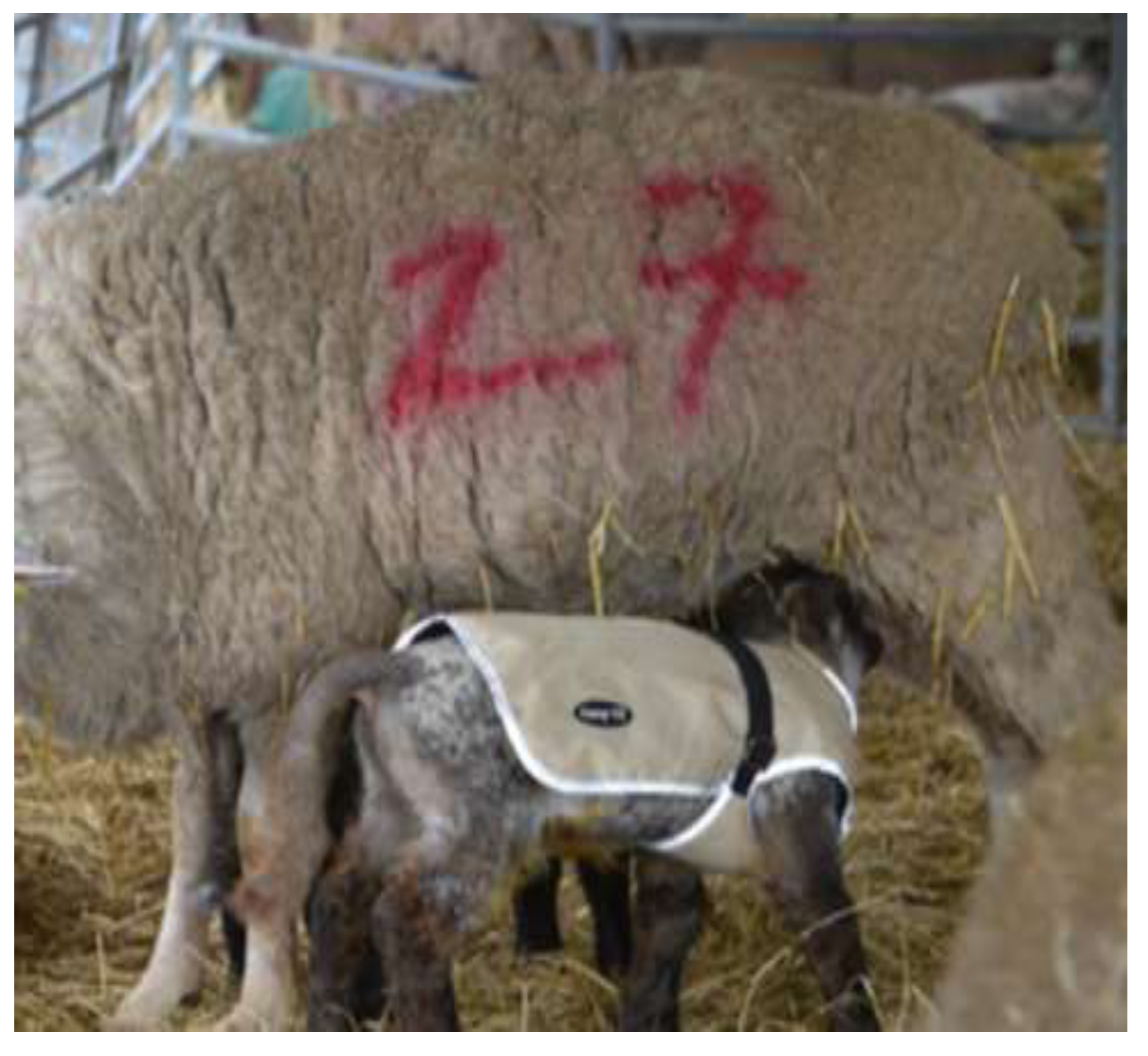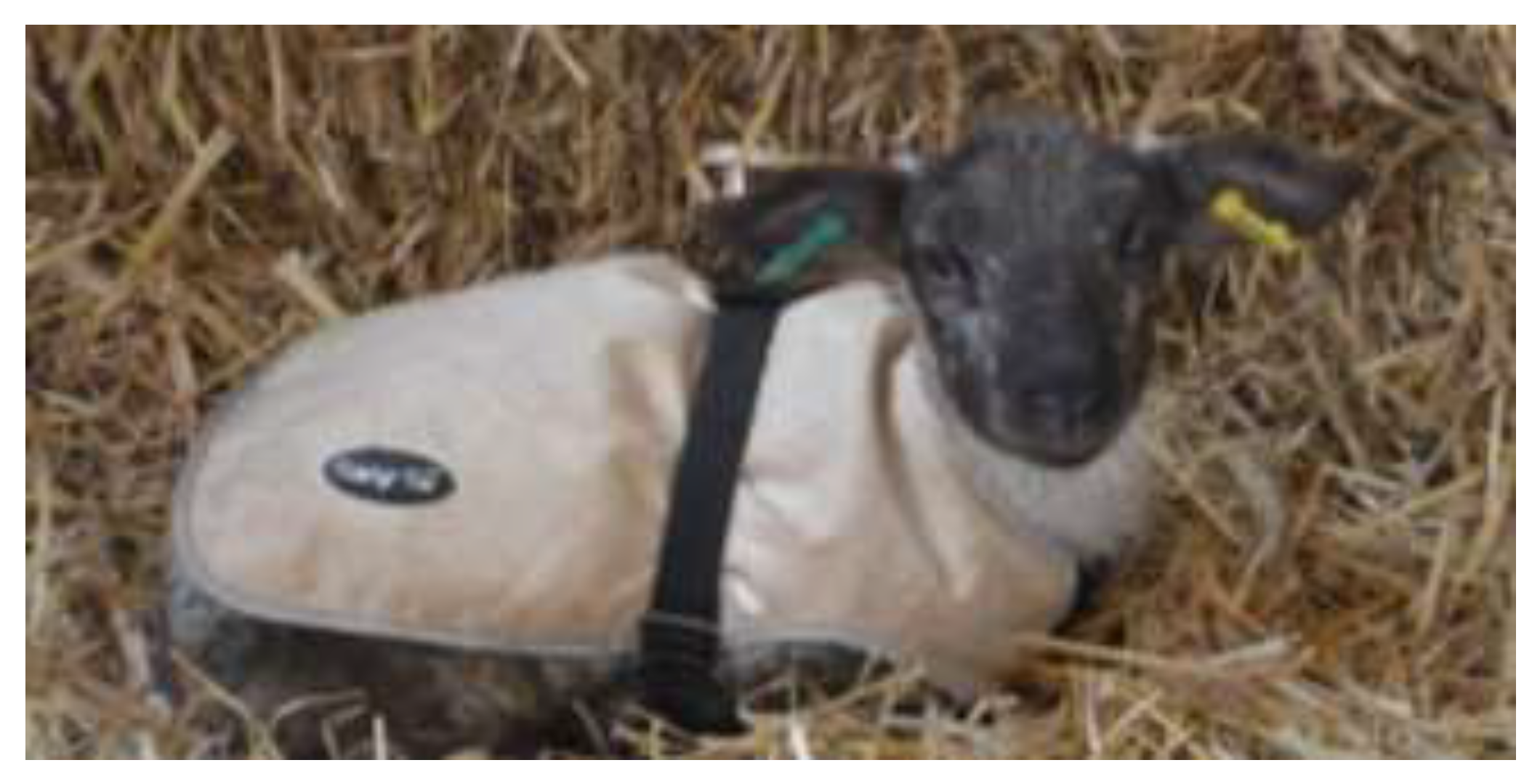The Impacts of Waterproof Insulated Jackets on Lamb Performance on a UK Lowland Farm
Abstract
:Simple Summary
Abstract
1. Introduction
2. Materials and Methods
2.1. Animals and Housing
2.2. Experimental Design
2.3. Measurements
2.4. Statistical Analysis
3. Results
3.1. Live Weight and Daily Weight Gain
3.2. Surface and Estimated Body Temperature
3.3. Ambient Temperature
4. Discussion
5. Conclusions
Author Contributions
Funding
Institutional Review Board Statement
Informed Consent Statement
Data Availability Statement
Acknowledgments
Conflicts of Interest
References
- HCC Lambing Project. Available online: https://meatpromotion.wales/en/industry-resources/sheep-management/research/lamb-losses-project (accessed on 28 September 2020).
- Stevenson, H. Conditions of neonatal lambs. Livestock 2014, 19, 41–46. [Google Scholar] [CrossRef]
- Eales, F.A. Some determinants of heat production capacity and susceptibility to hypothermia in newborn lambs. Ph.D. Thesis, University of Edinburgh, Edinburgh, UK, 1983. [Google Scholar]
- Alexander, G. Energy metabolism in the starved new-born lamb. Aust. J. Agric. Res. 1962, 13, 144–164. [Google Scholar] [CrossRef]
- Samson, D.E.; Slee, J. Factors affecting resistance to induced body cooling in newborn lambs of 10 breeds. Anim. Sci. 1981, 33, 59–65. [Google Scholar] [CrossRef]
- McCutcheon, S.N.; Holmes, C.W.; McDonald, M.F.; Rae, A.L. Resistance to cold stress in the newborn lamb 2. Role of body weight, birth rank, and some birth coat characters as determinants of resistance to cold stress. N. Z. J. Agric. Res. 1983, 26, 175–181. [Google Scholar] [CrossRef] [Green Version]
- McCutcheon, S.N.; Holmes, C.W.; McDonald, M.F.; Rae, A.L. Resistance to cold stress in the newborn lamb 1. Responses of romney, drysdale × romney, and merino lambs to components of the thermal environment. N. Z. J. Agric. Res. 1983, 26, 169–174. [Google Scholar] [CrossRef]
- Alexander, G. Temperature regulation in the new-born lamb. Iv. The effect of wind and evaporation of water from the coat on metabolic rate and body temperature %j australian journal of agricultural research. Aust. J. Agric. Res. 1962, 13, 82–99. [Google Scholar] [CrossRef]
- Alexander, G.; Williams, D. Shivering and non-shivering therogenesis during summit metabolism in young lambs. J. Physiol. 1968, 198, 251–276. [Google Scholar] [CrossRef]
- El-Bahr, R.A.D.S.M. Neonatal lamb behaviour and thermoregulation with special reference to thyroid hormones and phosphorous element: Effect of birth weight and litter size. J. Vet. Med. Res. 2008, 18, 120–127. [Google Scholar]
- Dwyer, C.M.; Morgan, C.A. Maintenance of body temperature in the neonatal lamb: Effects of breed, birth weight, and litter size. J. Anim. Sci. 2006, 84, 1093–1101. [Google Scholar] [CrossRef] [Green Version]
- Symonds, M.E. Brown adipose tissue growth and development. Scientifica 2013, 2013, 305763. [Google Scholar] [CrossRef] [Green Version]
- Symonds, M.E.; Andrews, D.C.; Johnson, P. The control of thermoregulation in the developing lamb during slow wave sleep. J. Dev. Physiol. 1989, 11, 289–298. [Google Scholar] [PubMed]
- Alexander, G. Temperature regulation in the new-born lamb. V. Summit metabolism %j Australian. J. Agric. Res. 1962, 13, 100–121. [Google Scholar] [CrossRef]
- Arnold, G.W.; Morgan, P.D. Behaviour of the ewe and lamb at lambing and its relationship to lamb mortality. Appl. Anim. Ethol. 1975, 2, 25–46. [Google Scholar] [CrossRef]
- Menant, O.; Ungerfeld, R.; Pérez-Clariget, R.; Freitas-de-Melo, A. Is body surface temperature measured on the single lambs’ back a reliable indicator of the ewe-lamb bond around birth? J. Therm. Biol. 2020, 93, 102699. [Google Scholar] [CrossRef] [PubMed]
- Ames, D.R.; Brink, D.R. Effect of temperature on lamb performance and protein efficiency ratio. J. Anim. Sci. 1977, 44, 136–144. [Google Scholar] [CrossRef]
- Ames, D.R.; Nellor, J.E.; Adams, T. Energy balance during heat stress in sheep. J. Anim. Sci. 1971, 32, 784–788. [Google Scholar] [CrossRef]
- Alexander, G. Heat loss from sheep. In Heat Loss from Animals and Man: Assessment and Control; Butterworth–Heinemann: Oxford, UK, 1974; pp. 173–203. [Google Scholar]
- Slee, J. The effects of breed, birthcoat and body weight on the cold resistance of newborn lambs. Anim. Sci. 1978, 27, 43–49. [Google Scholar] [CrossRef]
- Gregory, N.G.; Haslett, S.J.; Pedley, J.C. Studies on lamb hypothermia using a model lamb. N. Z. J. Agric. Res. 1999, 42, 179–185. [Google Scholar] [CrossRef] [Green Version]
- Sahoo, A.; Paul, R.K.; Thirumurgan, P.; Sharma, S.; Kumawat, P.K.; De, K. Immunological and plasma antioxidant response following protection of newborn lambs from cold by umbrella-type housing and lamb-jacket in winter. Biol. Rhythm Res. 2019, 1–8. [Google Scholar] [CrossRef]
- Earley, B.; Murray, M.; Farrell, J.A.; Nolan, M. Rearing calves outdoors with and without calf jackets compared with indoor housing on calf health and live-weight performance. Ir. J. Agric. Food Res. 2004, 43, 59–67. [Google Scholar]
- Rutherford, N.H.; Gordon, A.W.; Arnott, G.; Lively, F.O. The effect of calf jackets on the health, performance, and skin temperature of dairy origin beef calves. Transl. Anim. Sci. 2019, 4, 316–323. [Google Scholar] [CrossRef] [PubMed] [Green Version]
- Scoley, G.; Gordon, A.; Morrison, S.J. The effect of calf jacket usage on performance, behaviour and physiological responses of group-housed dairy calves. Anim. Int. J. Anim. Biosci. 2019, 13, 2876–2884. [Google Scholar] [CrossRef] [PubMed]
- Hamadeh, S.K.; Hatfield, P.G.; Kott, R.W.; Sowell, B.F.; Robinson, B.L.; Roth, N.J. Effects of breed, sex, birth type and colostrum intake on cold tolerance in newborn lambs. Sheep Goat Res. J. 2000, 16, 46–51. [Google Scholar]
- Clarke, L.; Heasman, L.; Firth, K.; Symonds, M.E. Influence of route of delivery and ambient temperature on thermoregulation in newborn lambs. Am. J. Physiol. 1997, 272, R1931–R1939. [Google Scholar] [CrossRef] [PubMed]
- Symonds, M.E.; Bird, J.A.; Sullivan, C.; Wilson, V.; Clarke, L.; Stephenson, T. Effect of delivery temperature on endocrine stimulation of thermoregulation in lambs born by cesarean section. J. Appl. Physiol. 2000, 88, 47–53. [Google Scholar] [CrossRef] [PubMed] [Green Version]
- Symonds, M.; Andrews, D.; Buss, D.; Clarke, L.; Darby, C.; Johnson, P.; Lomax, M. Environmental effects on thermoregulation and breathing patterns during early postnatal development in hand-reared lambs. Exp. Physiol. Transl. Integr. 1995, 80, 779–792. [Google Scholar] [CrossRef] [Green Version]
- Alexander, G.; McCance, I. Temperature regulation in the new-born lamb. I. Changes in rectal temperature within the first six hours of life. Aust. J. Agric. Res. 1958, 9, 339–347. [Google Scholar] [CrossRef]




| Parameter | Treatment | Day | p-Value | |||||||
|---|---|---|---|---|---|---|---|---|---|---|
| 0 | 2 | 7 | 14 | 21 | SE | Day | Jacket | Day × Jacket | ||
| LW (kg) | NJ | 4.89 | 5.47 | 6.70 | 8.13 | 8.76 | 0.205 | <0.001 | 0.743 | 0.528 |
| J | 4.82 | 5.52 | 6.78 | 8.21 | 9.20 | |||||
| ADG (kg/d) a | NJ | - | 0.29 | 0.25 | 0.20 | 0.19 | 0.018 | <0.001 | 0.496 | 0.123 |
| J | 0.35 | 0.25 | 0.21 | 0.17 | ||||||
| Parameter | Treatment | Hours after Birth | p-Value | ||||||
|---|---|---|---|---|---|---|---|---|---|
| 0 | 12 | 24 | 48 | SE | Time | Jacket | Time × Jacket | ||
| Surface Temperature (°C) | NJ | 23.28 | 24.73 | 23.86 | 22.74 | 0.201 | <0.001 | <0.001 | <0.001 |
| J | 22.94 | 28.09 | 28.10 | 27.04 | |||||
| Estimated Body Temperature (°C) | NJ | 38.48 | 39.54 | 39.67 | 39.75 | 0.256 | <0.001 | 0.661 | 0.270 |
| J | 38.46 | 39.12 | 39.66 | 40.02 | |||||
Publisher’s Note: MDPI stays neutral with regard to jurisdictional claims in published maps and institutional affiliations. |
© 2021 by the authors. Licensee MDPI, Basel, Switzerland. This article is an open access article distributed under the terms and conditions of the Creative Commons Attribution (CC BY) license (http://creativecommons.org/licenses/by/4.0/).
Share and Cite
Collins, E.B.; Blackie, N. The Impacts of Waterproof Insulated Jackets on Lamb Performance on a UK Lowland Farm. Animals 2021, 11, 217. https://doi.org/10.3390/ani11010217
Collins EB, Blackie N. The Impacts of Waterproof Insulated Jackets on Lamb Performance on a UK Lowland Farm. Animals. 2021; 11(1):217. https://doi.org/10.3390/ani11010217
Chicago/Turabian StyleCollins, Eleanor Brooke, and Nicola Blackie. 2021. "The Impacts of Waterproof Insulated Jackets on Lamb Performance on a UK Lowland Farm" Animals 11, no. 1: 217. https://doi.org/10.3390/ani11010217
APA StyleCollins, E. B., & Blackie, N. (2021). The Impacts of Waterproof Insulated Jackets on Lamb Performance on a UK Lowland Farm. Animals, 11(1), 217. https://doi.org/10.3390/ani11010217





